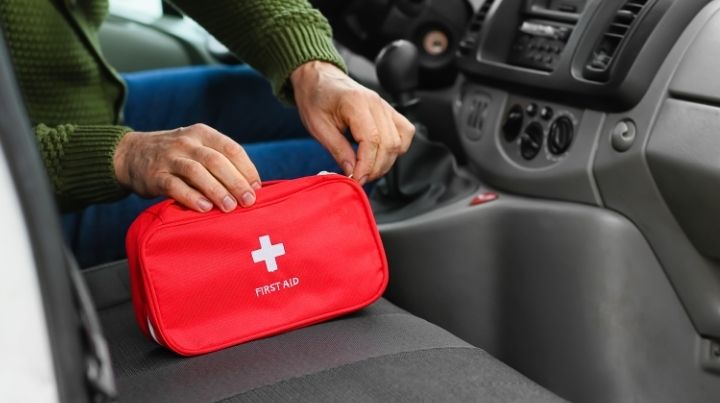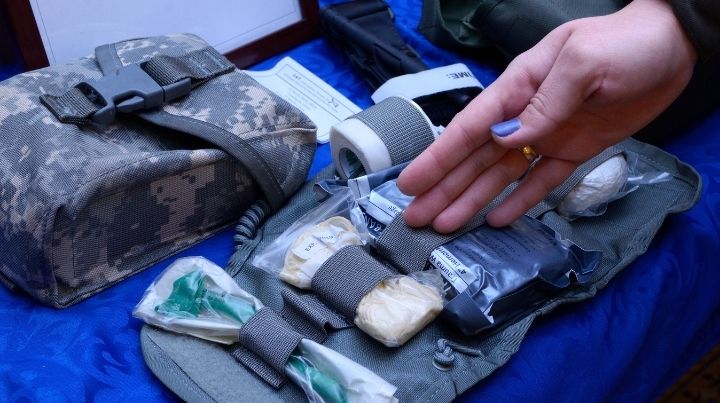What to Keep in Your Trauma Medical Kit

Do you carry a trauma medical kit in case of an accident or a mass casualty event? If not, it's an addition you might consider making to your home or vehicle emergency kit. What should you have in your trauma medical kit?
Well, before you even begin building a trauma medical kit, the first thing you need is knowledge. You may already have that knowledge, but if you don't, it's essential to learn these lifesaving skills.
Look for a Stop the Bleed class, a CPR class, and better yet, a trauma medical class in order to be able to use the tools in your bag. A wilderness medical class can be a goldmine of information for preppers because it assumes that help will not be arriving soon.
Size Up, Safety, and HELP!
The first priority of any situation is your safety! If you are injured or overcome by the event, you're ability to provide effective help will be limited or in the worst-case scenario negated altogether.
So be smart and size up the situation before heading into it. Once you've determined the situation is safe to enter, call out to the casualty before touching them to see if they are conscious and responsive.
With the situation sized up, make sure to put out a call for help if needed. In the end, never forget, a seriously injured person requires a hospital and you are not it.
So, get help moving as soon as possible to cut down on the time it takes to get the casualty to definitive care.
Massive Hemorrhage
The first thing to make certain of when you come across a casualty is that the victim is to check for massive bleeding. A person with a serious bleed can die in just a few minutes. So, do a quick head-to-toe sweep to find any problematic bleeding.
Follow this acronym by Rom Duckworth to treat massive hemorrhage:
“Massive hemorrhage can be addressed by the four Ds:
-
Detect: find the source of the bleeding.
-
Direct pressure: hold pressure on the source of the bleeding until the clot forms.
-
Devices: if necessary, use equipment such as tourniquets, hemostatic gauze, and pressure bandages to supplement direct pressure.
-
Don't dilute: use the concept of hypotensive resuscitation to avoid thinning the blood or pumping established clots.”
People often focus on stopping bleeding in their trauma kits. There are different tools for different types of bleeding. Basically, you want to be able to treat a bleeding wound with direct pressure, stop the bleeding from a spurting artery or amputation, and treat a sucking chest wound.
Be sure to protect yourself from bloodborne pathogens, particularly if the victim is a stranger. Always use gloves.
Trauma Medical Kit Massive Hemorrhage Support Items:
- North American Rescue Combat Application Tourniquet (C-A-T)
- Tactical Medical Solutions SOFTourniquet
- Quick Clot Advanced Clotting Gauze
- Compression bandage
- Sterile Abdominal Pads
- Chest seal
- Surgical tape
- Stretchy rolled gauze
Airway Control
Once you have any life-threatening bleeding taken care of, the next step is to control a casualties airway.
Often, breathing issues can be rectified by gently putting them in a position that opens their airway. Special care should be taken if a head, neck, or spinal injury is suspected, but the airway must still be opened if you want your patient to survive.
Put one hand on their forehead, tip their head back, and slightly open the mouth by placing two fingers on the chin and pressing down slightly. This position gets their tongue out of the way and opens the airway.
If you are concerned about spinal injuries, don't move their head, but simply reposition their jaw forward to open the airway.
Trauma Medical Kit Airway Support Items:
- Nasopharyngeal airway and lubrication (only use this if you've had training)
Respiratory Support
With the airway open, your next task is to check for visible signs of breathing. Is their chest rising and falling? Can you feel the exhalations of their breath?
If not, this is where your CPR training will be needed. It will be up to you to support their respiration, which helps fresh oxygen get into their system and to their brain.
Remember, a person who stops breathing will begin to suffer brain damage in as little as three minutes.
Trauma Medical Kit Respiratory Support Items:
- Fingertip pulse oximeter (it can be easier than finding a weak pulse if you're not accustomed to searching for pulses)
- Disposable face shields for rescue breathing
Circulation
With your patient's respirations taken care of, you will need to make sure their oxygen is adequately circulated so that it gets to their brain and other organs.
If their heart isn't beating you will have to support their circulatory needs by putting your CPR skills to the test.
Hypothermia
Hypothermia is an often forgotten problem that can kill a casualty, especially a casualty suffering from severe blood loss.
When it comes to hypothermia, Rom Duckworth writes:
“As the patient goes into shock, his body temperature drops, reducing his blood’s ability to clot.”
Therefore, it's critical to keep your patient warm. Maintaining a patient's body temperature includes keeping them warm and keeping them off the ground.
Trauma Medical Kit Hypothermia Support Items:
Head Injury
Following hypothermia, head injuries are the next area you will need to address.
One of the primary treatment measures for head injuries is to keep a patient oxygenated. So, make sure to double-check a person's respirations.
Trauma Medical Kit: Other Supplies
There are other supplies that you should add to your medical kit.
- Shears – you may need to have to cut someone's clothing away from a wound
- Nitrile gloves
- Hand sanitizer
- Rubbing alcohol (to sanitize tools)
- Tweezers
- Emergency blankets
- Eyewash solution and an eyewash cup
- Large triangular bandage
- Splint
- Aspirin
- Benadryl
- First Aid Manual
- SAM splint
Remember, the goal of a trauma medical kit is not the same as your home first aid kit. You aren't treating illnesses for the long term with this kit. You are handling first aid in the event of an accident or potentially deadly health event. So a more focused kit is in order for these types of situations.
Here's one you can purchase pre-assembled that contains most of the items we discussed.
If Help Is Not On the Way
Depending on the scenario, you could find yourself in a situation where help is not on the way. (Say you're out hiking or the system has collapsed, or whatever.) If you are concerned about cases like that, you may want a few additions to your kit.
- Antiseptic wound wash
- Curad Silver Wound Gel
- Ibuprofen
- Irrigation syringe for cleaning wounds
- Burn cream
- Butterfly bandages
- Safety pins
- Ace bandage (elastic wrap)
- Pepto Bismol
- Hydrocortisone cream
- Curved and straight hemostatic clamps
Many of these items are essential in the prevention of infection in wounds. These additional items don't take up a lot of space and can enhance your trauma medical kit for unexpected delays.
What Do You Keep in Your Trauma Medical Kit?
What supplies do you keep in your trauma medical kit? Are there any items here that you hadn't considered and plan to add? Are there items not included that you'd recommend? Share your thoughts in the comments.
Additional Resources:
Stop The Bleed Training: https://www.stopthebleed.org/training
CPR Training: https://www.redcross.org/take-a-class/cpr
C.E.R.T. Training (Community Emergency Response Team): https://community.fema.gov/PreparednessCommunity/s/welcome-to-cert
Don't Miss Out!
Join the thousands of people who rely on Mind4Survival preparedness advice by subscribing to our FREE newsletter.
- Practical preparedness information
- Zero Spam
- < 0.25% of people unsubscribe




Join Mind4Survival!
Stay informed by joining the Mind4Survival! 100% Secure! 0% Spam!
Follow Us!
Affiliate Disclosure
Mind4Survival is a free, reader-supported information resource. If you make a purchase through our link, we may, at no cost to you, receive an affiliate commission.



My first aid kits are always an ongoing project. What size bandaids do I use the most? How do I store OTC drugs. Which ones have I used (and replaced) which ones did I need and did not have?
Great work Brian, as always. Keep it up!